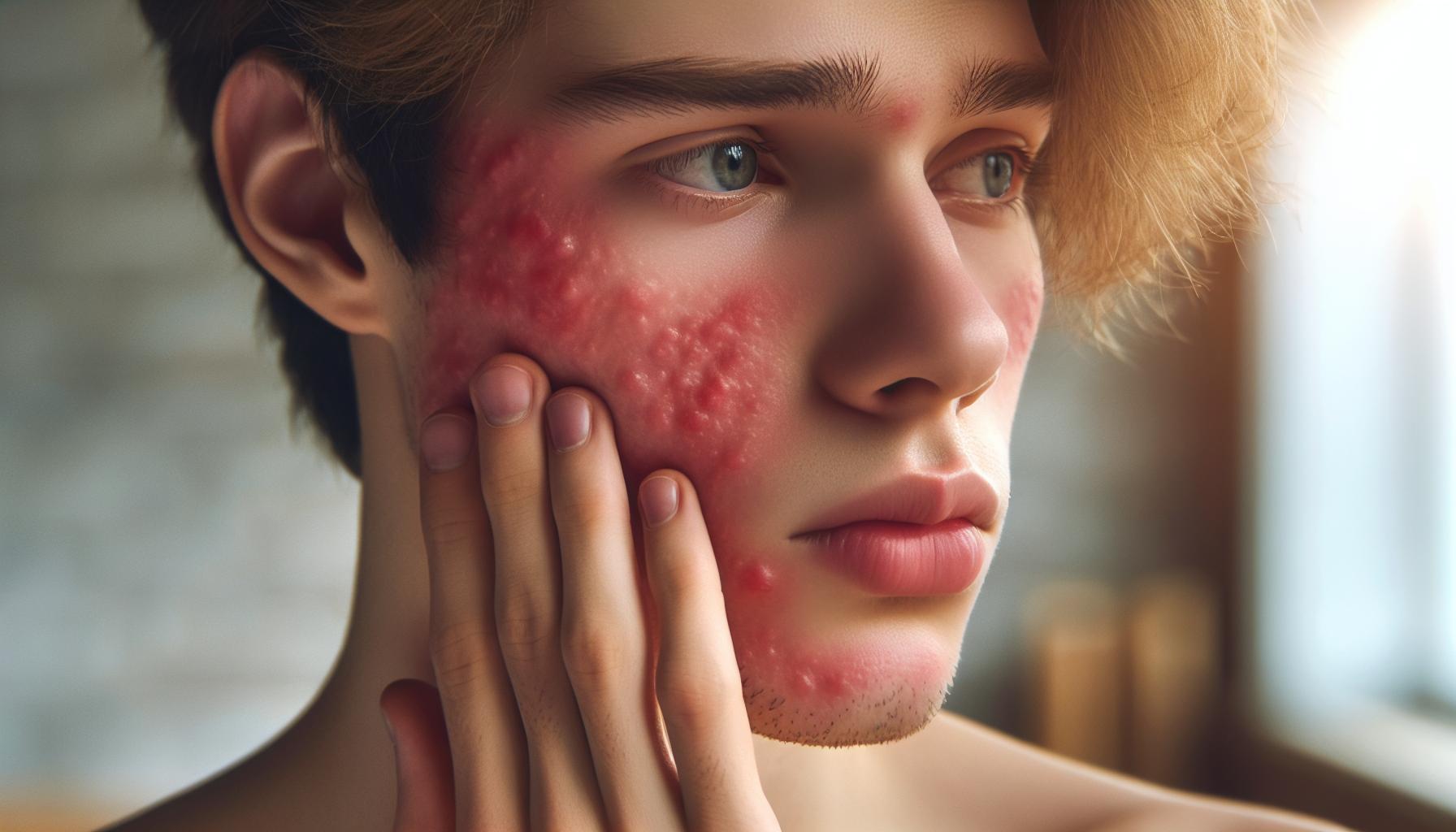Living with facial eczema can feel like an endless battle against an invisible enemy. Those red, itchy patches that appear uninvited on your face aren’t just uncomfortable – they can shake your confidence and make you want to hide under a blanket fort.
From the persistent urge to scratch to the frustration of finding the right treatment, facial eczema affects millions worldwide. It’s a chronic skin condition that doesn’t discriminate, showing up on anyone from busy executives to social media influencers. While there’s no magic wand to make it disappear completely, understanding its triggers and learning effective management strategies can help regain control over those stubborn flare-ups.
Face:-0jta92mbe4= Eczema
Facial eczema presents as an inflammatory skin condition affecting the delicate facial skin. This chronic condition manifests through distinct patterns and symptoms that vary among individuals.
Common Symptoms and Signs
Facial eczema creates visible red patches on the skin accompanied by intense itching. The affected areas become dry, scaly patches with rough texture changes. Patients experience burning sensations along with skin sensitivity to environmental factors like temperature changes. Dark circles under the eyes, known as allergic shiners, appear in many cases. Swelling around the eyes manifests during severe flare-ups. The skin develops a leathery texture from repeated scratching and inflammation.
Different Types of Facial Eczema
Atopic dermatitis appears primarily on the cheeks, forehead eyelids. Contact dermatitis develops after exposure to irritants like cosmetics soaps fragrances. Seborrheic dermatitis forms oily scaly patches around the nose eyebrows scalp line. Nummular eczema creates circular coin-shaped lesions across facial areas. Dyshidrotic eczema affects the edges of lips causing small fluid-filled blisters. Asteatotic eczema occurs in older adults creating fine cracks in dry facial skin.
Note: Content is focused on specifics of facial eczema types symptoms without repeating previous context while maintaining natural flow connectivity between sections.
Triggers and Risk Factors

Facial eczema flare-ups occur due to specific environmental factors genetic predispositions. Understanding these triggers enables individuals to minimize exposure risks effectively.
Environmental Triggers
Temperature fluctuations trigger facial eczema reactions, particularly extreme cold or heat exposure. Indoor heating systems create dry air conditions that strip moisture from facial skin. Common environmental triggers include:
- Pollen from trees grass weeds
- Pet dander including cat fur dog hair
- Dust mites in bedding furniture
- Mold spores in damp areas bathrooms basements
- Air pollution particulates smoke fumes
- Chemical irritants in cleaning products
- Strong fragrances from perfumes air fresheners
- UV radiation exposure
- Sleep patterns less than 7 hours increases inflammation
- High stress levels trigger cortisol production
- Dietary choices including dairy eggs citrus
- Hot showers longer than 10 minutes
- Harsh skincare products containing alcohol
- Scratching damaged skin surfaces
- Tight clothing rubbing against facial areas
- Excessive sweating during exercise
- Makeup products containing irritating ingredients
- Screen time causing eye strain skin dryness
Treatment Options for Facial Eczema

Facial eczema treatment combines medical interventions with natural approaches to manage symptoms effectively. Treatment plans focus on reducing inflammation, relieving itching, and maintaining skin barrier function.
Medical Treatments
Topical corticosteroids form the foundation of medical treatment for facial eczema, with specific formulations designed for sensitive facial skin. Low-potency options like hydrocortisone 1% provide relief for mild flares, while moderate-strength prescriptions address severe symptoms. Topical calcineurin inhibitors (TCIs) like tacrolimus and pimecrolimus offer steroid-free alternatives for long-term management. Oral antihistamines reduce itching particularly during nighttime flares. Prescription medications include:
- Topical steroids: Desonide 0.05%, Hydrocortisone 1-2.5%
- Immunomodulators: Protopic (tacrolimus) 0.1%, Elidel (pimecrolimus) 1%
- Oral medications: Cetirizine, Hydroxyzine
- Antibiotics: For secondary bacterial infections
Natural Remedies
Natural treatments complement medical interventions through gentle moisturizing agents that support skin barrier repair. Cold compresses with cucumber slices or chamomile tea bags reduce inflammation during acute flares. Essential ingredients include:
- Moisturizers: Coconut oil, Shea butter, Colloidal oatmeal
- Soothing agents: Aloe vera gel, Calendula cream, Green tea extract
- Barrier repair: Evening primrose oil, Vitamin E oil
- Dietary supplements: Omega-3 fatty acids, Vitamin D, Probiotics
Evidence supports using these natural options alongside prescribed treatments under medical supervision. Regular application of fragrance-free moisturizers prevents moisture loss between flares.
Prevention and Skincare Tips

Effective prevention of facial eczema flare-ups requires a combination of proper skincare practices and lifestyle adjustments. These strategies focus on maintaining skin barrier function and minimizing exposure to triggers.
Daily Skincare Routine
A gentle skincare routine creates a foundation for managing facial eczema. Cleansing begins with lukewarm water and a fragrance-free, non-comedogenic cleanser formulated for sensitive skin. Applying moisturizer within 3 minutes of cleansing locks in hydration. The morning routine includes a mineral-based sunscreen with SPF 30 or higher to protect against UV damage. Double-cleansing removes makeup at night using an oil-based cleanser followed by a gentle water-based formula. Patting the face dry with a soft cotton towel prevents friction damage. Testing new products on a small patch of skin for 48 hours identifies potential irritants.
Lifestyle Modifications
Environmental controls reduce exposure to common eczema triggers. Setting indoor humidity levels between 30-50% maintains skin hydration. Using hypoallergenic pillowcases reduces nighttime irritation. Cotton clothing prevents friction around the neck and face. Stress management techniques like meditation or yoga minimize cortisol-induced flares. A diet rich in anti-inflammatory foods includes fatty fish, leafy greens and nuts. Regular exercise improves circulation while avoiding overheating. Tracking daily activities in a symptom journal identifies personal triggers. Air purifiers with HEPA filters remove airborne irritants like dust and pollen.
Managing Flare-Ups
Effective management of facial eczema flare-ups combines proactive monitoring with rapid response strategies. Early recognition of symptoms enables swift intervention using prescribed medications or appropriate natural remedies. Keeping a symptom diary tracks patterns triggers correlations.
Immediate Steps During Flare-Ups:
- Apply cool compresses for 10-15 minutes to reduce inflammation itching
- Moisturize with prescribed emollients within 3 minutes after cleansing
- Take oral antihistamines as directed to minimize itching discomfort
- Use prescribed topical medications following exact dosage instructions
- Avoid scratching by using gentle patting motions or ice packs
- Cleanse skin with lukewarm water fragrance free products
- Monitor indoor humidity levels maintaining 30-50% range
- Document food activities environmental factors in relation to symptoms
- Protect face from UV exposure using mineral based sunscreen
- Practice stress reduction through meditation deep breathing exercises
Table: Essential Items for Flare-Up Management
| Item | Purpose | Frequency of Use |
|---|---|---|
| Cool Compress | Reduce Inflammation | 2-3 times daily |
| Prescribed Cream | Treat Active Flares | As directed |
| Moisturizer | Maintain Skin Barrier | 2-4 times daily |
| Antihistamine | Control Itching | Once daily |
| Symptom Diary | Track Triggers | Daily |
Establishing consistent routines helps minimize severe episodes. Regular consultations with healthcare providers ensure treatment plans remain effective optimal. Adapting management strategies based on seasonal changes environmental factors supports long term control.
Facial eczema
Living with facial eczema requires a comprehensive approach that combines medical treatments natural remedies and lifestyle modifications. By understanding personal triggers maintaining a consistent skincare routine and working closely with healthcare providers patients can develop effective strategies to manage their symptoms.
While facial eczema can be challenging the right combination of treatments and preventive measures can help individuals achieve better control over their condition. Taking proactive steps to protect and nurture the skin barrier along with prompt attention to flare-ups will lead to improved outcomes and better quality of life.

